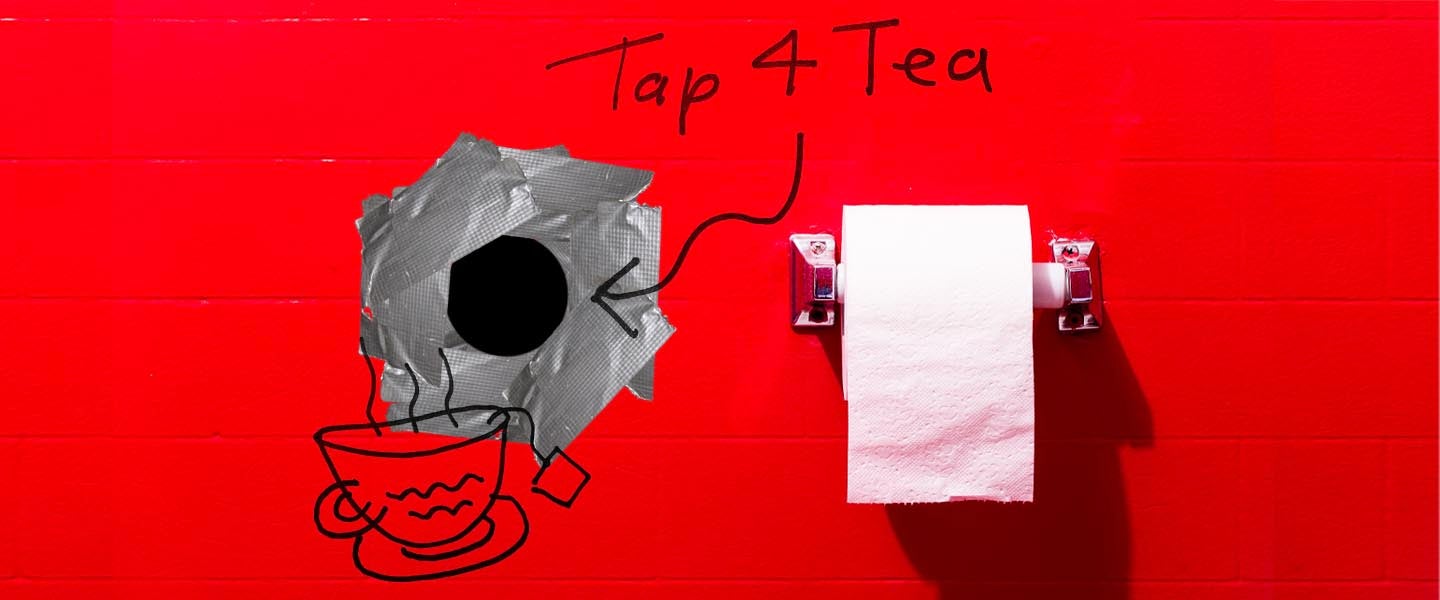Back in 2007, Republican Senator Larry Craig found himself in the midst of a media shitstorm that offered a glimpse into a hidden, occasionally dangerous pocket of gay history. According to a police report, which quickly ruined both his career and reputation, the senator was hiding out in a Minnesota airport bathroom stall when a cop entered the stall next to him. “At 1216 hours, Craig tapped his foot,” wrote the cop, who recognized this as a “signal used by persons wishing to engage in lewd conduct.”
Things escalated quickly over the next few minutes, with Craig first brushing the officer’s foot with his own and then reaching down to slide his wedding ring-clad hand under the divider. In case you hadn’t guessed, Craig was sending a very clear message: He was very much DTF.
This game of kinky cat-and-mouse is known as “tapping.” It started in the days before gay sex was decriminalized, when men would frequent public restrooms in the hopes of finding someone to fuck. In the U.K., these hotspots were called “cottages”; in the U.S., they were called “tearooms” — ironically, a term rumored to reference the British slang term “tea,” which means “piss.” Glory holes were sometimes drilled into walls for ease, but not always — and police officers naturally sought them out and covered them up, so old-school gays had to get creative with their tapping protocol.
As always, Reddit houses some pretty valuable, niche insight. One user, hilariously named NotLarryCraig, breaks things down pretty comprehensively: “A guy looking for sex in a public restroom will choose a stall farthest from the door. Someone else looking will sit in the stall right next to it. A guy looking for sex in a public restroom pulls his pants and underwear all the way down to his ankles while sitting. He taps his foot, slowly at first. Both know to look at the feet.”
The back-and-forth continues until both guys are pretty sure there’s a shared aim — obviously, this is where Craig fucked up. Then comes the hand, followed by a dick ready to be sucked.
Internet folklore suggests there are specific codes, one of which is rumored to be 4-2-9 — a reference to the numbers used to tap out “G-A-Y” on an old-school phone — but none of the three LGBTQ+ history professors I interviewed knew anything about it. Of course, that’s not to say it didn’t exist — more that firsthand knowledge has been destroyed through censorship, erasure and the decimation of an older, pre-internet gay generation by the AIDS crisis.
Robert Yang spent plenty of time researching the world of tearooms before developing his independent game, The Tearoom. His main point of reference was Laud Humphreys’ The Tearoom Trade, which aimed to understand the men who fucked in public. An earlier British book, For Your Convenience, published in 1937, took a different approach, advising potentially interested guys on which restrooms they could frequent to get their rocks off, and what kind of guys they would find there.
As for specific codes, Yang says he doesn’t “remember reading about specific patterns — surely any type of lingering or peculiar foot-tapping would be clear enough? But, as Tearoom Trade shows, a tearoom was also a social community with its own norms, so I wouldn’t be surprised if an informal code caught on, or if different cottages / tearooms had different traditions.”
Criminalization has always forced queer communities to get creative. Back in the 1970s, there was the handkerchief code, which required guys to tuck one into their back pocket to signal they were looking. Colors were non-verbal signifiers of different kinks, some of which were obvious: Yellow was for watersports; brown was for scat. Others were less obvious: Purple signaled a fetish for piercings; red for fisting; and orange for, well, pretty much anything. Then, there was Polari, a kind of scrambled, seemingly nonsensical language used to avoid being clocked and potentially abused by cops.
Now, it’s arguable that these codes are less necessary than ever. (It should be noted, however, sex in a public toilet remains illegal in the U.K. and the U.S., where stings still happen pretty regularly.) If anything, as an anonymous cruiser tells me, apps like Grindr have stepped in where these intricate rituals of foot-tapping left off. “I’m not familiar with protocol, but I think cottaging has sort of synced with apps in a way — I’ve been on Grindr at [train or bus] stations on occasion, and people will write that they’re waiting in a particular [stall].”
But more generally, he argues, cruising is dying out. “The liberation of the LGBTQ+ community has made saunas way more socially acceptable,” he says, explaining that some have become important gay hangout spots in their own right. Mark Oakley, owner of The Eagle London, a hugely popular former sex club, agrees that old-school cruising and cottaging have been killed by tech. “Young men nowadays just turn on their phone, and within milliseconds, they’re in contact with other men, or they’re watching a sex scene online. There’s no need to go to that big, dark gay club any more — just turn on your phone and arrange to meet them in a cafe or a bar.”
As with all progress, however, there are inevitable drawbacks. “People would say that we’ve increased protection now, but also that it’s taken the thrill out of it,” says Oakley. “I was a cruising-zone user myself in my early teens. I used to love the idea of being able to have sex walking through the park on the way home. Well, a park or a public toilet — that’s all that was really accessible in the 1980s and 1990s!”
“There was always a scene if you wanted it,” he continues. “You had to go looking for it and be very cautious, but that was always part of the excitement. Because when you finally did discover it, it was a magical mystery world like no other!”

